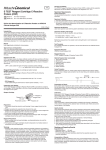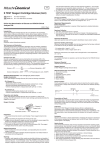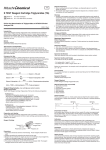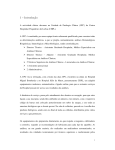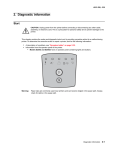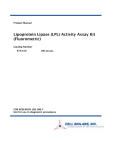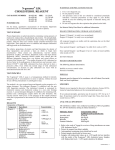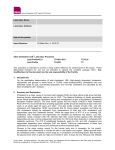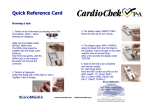Download S TEST Reagent Cartridge Low Density Lipoprotein Cholesterol (LDL)
Transcript
S TEST Reagent Cartridge Low Density Lipoprotein Cholesterol (LDL) 96313-10 96313-100 10 S TEST Cartridges 10 x 10 S TEST Boxes (100 Tests) Kit for the determination of Low Density Lipoprotein Cholesterol on HITACHI Clinical Analyzer 2011-11 Rev.0 Intended Use The S TEST LDL is intended for the quantitative determination of low density lipoprotein cholesterol concentration in serum or heparin plasma using the HITACHI Clinical Analyzer. The S TEST LDL is intended for use in clinical laboratories or physician office laboratories. For in vitro diagnostic use only. Method Enzymatic direct method LDL-Cholesterol level is generally calculated from the measurements of total cholesterol, HDL-Cholesterol, and triglycerides using Friedewald’s formula, but this calculation method is not sufficient for an accurate determination of LDL-Cholesterol. The reference method for LDL-Cholesterol is the ultracentrifugation method, but the method requires specialized instrumentation and a long measurement time. This makes the reference method difficult to perform in routine laboratory tests, and direct methods are widely used. Principle of the Test The presented method using a combination of two surfactants is based on a fact that each lipoprotein reacts with different surfactants depending on their intrinsic physicochemical property. In the first reaction, Surfactant 1 changes the structure of only those lipoproteins other than LDL (i.e., chylomicron [CM], VLDL, and HDL), and the resulting cholesterol is consumed by cholesterol oxidase and cholesterol esterase in a colorless reaction. In the second reaction, the remaining LDL is changed by Surfactant 2, and the resulting cholesterol is consumed in a color reaction. Surfactant 1 Cholesterol Cholesterol esterase H2O2 Cholesterol oxidase Peroxidase H2O2 + 4-Aminoantipyrine Colorless The second reaction LDL Cholesterol Other Precautions This product is intended for use on HITACHI Clinical Analyzer. The reagent cartridges should not be used for any other purposes. Storage and Stability LDL reagent cartridges are stable until the expiration date shown on the box labels when stored in the refrigerator at 2 – 8 °C. Surfactant 2 Cholesterol Cholesterol esterase H2O2 Cholesterol oxidase H2O2 + 4-Aminoantipyrine + DSBmT Peroxidase Purple-red pigment Reagent Requirements- one cartridge per patient sample Reagent Composition The S TEST LDL reagent cartridge has the following composition: LDL Reagent (1): • 4-Aminoantipyrine 0.01% • Cholesterol esterase (Microbial) <2.5 U/mL • Cholesterol oxidase (Microbial) 1.2 U/mL • Peroxidase (Horseradish) <1.3 ppg U/mL • Surfactant 1 • Good’s Buffer (pH 6.3) LDL Reagent (2): • Surfactant 2 • N,N-bis (4-sulfobutyl)-m-toluidine, disodium salt (DSBmT) 0.04% • Good’s Buffer (pH 6.3) Preparation and Labeling LDL reagent is provided in a ready-to-use cartridge. The 2D code label on the front of each cartridge automatically identifies the reagent to the system. Reagent Cartridge Reagent (1) Reagent (2) 2D code Photometric cuvette Patient Preparation No special patient preparation is required. Collect specimen by standard laboratory technique. Specimen Collection 1.Use clear, unhemolyzed serum or heparin plasma. 2.Care should be taken to preserve the chemical integrity of the blood specimen from the time it is collected until the time it is assayed (see SPECIMEN HANDLING AND STORAGE). Specimen Identification Label each specimen tube with the patient's identification (name and/or number). Specimen Handling and Storage Before the measurement, the sample must be brought back to room temperature (15 – 30 °C). If collected serum (plasma) cannot be tested on the same day, store it as follows. • For testing within 1 week: 2 – 10 °C • For testing after 1 week or longer: below -20 °C Test Procedure For complete information on operation, see the User Manual for the HITACHI Clinical Analyzer. Equipment Required HITACHI Clinical Analyzer The first reaction Cholesterol Disposal Precautions 1.When handling blood and used cartridges, use disposable gloves to avoid the danger of infection. 2.The samples and reagent cartridges should be disposed of as medical waste in accordance with local regulations. Specimen Requirements Test Summary and Explanation Low Density Lipoprotein (LDL)-Cholesterol is known to be a risk factor for arteriosclerotic disease, especially coronary disease. Determination of total cholesterol has been conventionally and widely used in the diagnosis of hyperlipidemia, which is considered a cause of arteriosclerotic disease. However, it has been reported that ischemic heart disease is more strongly correlated with LDL-Cholesterol than with total cholesterol. 1 HDL, VLDL, CM Precautions 1.This product should be stored to avoid freezing. Frozen reagent should not be used. 2.Reagent exceeding the expiration date should not be used. 3.Avoid direct sunlight during storage and measurement. 4.Avoid all contact with cartridge contents; do not ingest. 5.When handling samples, use disposable gloves to avoid the danger of infection. Do not pipette by mouth. 6.LDL Reagent (1) and (2) contain Proclin, an antiseptic which may be irritating to eyes, skin and mucous membranes. Reagent cells Reaction cell Reagent Required S TEST LDL reagent cartridge Material Required (but not provided) 1. Two levels of controls 2. Sample cups 3. Disposable transfer pipettes 4. Washing water 5. Alkali detergent 6. Waste container Assay Procedure Prior to performing each run, check system status to determine the need to replace washing water or empty waste container. See the User Manual for detailed operating instructions. Measurement (546 / 660 nm) Reagent (1) / Sample Reagent (2) 210 µL / 5 µL 70 µL 0 4.5 5.0 Measurement (546 / 660 nm) Conc. Calculation 10.0 (min) Presentation of Result Each Patient Report includes the data and time, sample ID number (as programmed), the test abbreviation, the test results, normal ranges and result flags. For detailed explanations on flags and error messages, refer to the User Manual. Calibration Each lot of S TEST LDL cartridges is calibrated by the manufacturer prior to shipment using material traceable to the Beta-Quantification Reference Method (CDC). The 2D code printed on each cartridge provides the analyzer with lot-specific calibration data. Calculation LDL-Cholesterol concentration is directly determined by multiplying the change in absorbance of the unknown samples by the calibrator factor on the 2D code. Patient and control results appear on the display. Quality Control Users should follow federal, state and local regulatory requirements regarding quality control practices. See instrument manual for procedures on how to run controls. Good laboratory practice includes the use of at least two levels of control material to ensure the test performance. The frequency and limits of QC testing should be determined according to individual laboratory standard QC procedures. Controls should be run at least once every 30 days and: 1.When test results do not match patient symptoms or clinical findings. 2.When using a new lot or shipment of reagents. 3.When laboratory environmental conditions have significantly changed. 4.When training or retraining of personnel occurs. the HITACHI Clinical Analyzer with S TEST LDL. Approximately 40 matched serum/ plasma samples that spanned the dynamic range were assayed in singleton and the results were compared using least squares liner regression (plasma = y-axis). The performance characteristics were as follows. Reading and Reporting Results y = 1.01x -4.4 correlation coefficient (r) = 0.99 95% confidence interval of the slope = 0.99 to 1.02 95% confidence interval of the y-intercept -6.4 to -2.3 Expected Value • Reportable range: 8 – 400 mg/dL • Reference range: 70 – 139 mg/dL 1, 2 • Optimal: <100 mg/dL, Near optimal: 100 – 129 mg/dL, Borderline high: 130 – 159 mg/dL, High: 160 – 189 mg/dL, Very high: >189 mg/dL 3 • It is recommended that each laboratory determine the expected values for its particular population. Interpretation of Results There may be reactions with non-target substances or interfering reactions. If measured results seem unreliable, repeat the measurement (if necessary after dilution) or try another analytical measurement. Detection limit (per CLSI EP17-A) The detection limit was determined to be 0.8 mg/dL. Linearity (per CLSI EP6-A) The assay linearity was determined to be 3 mg/dL to 430 mg/dL. Reportable Range 8 mg/dL to 400 mg/dL Handling Critical Values If the result of a sample exceeds the measurement range, dilute the sample with physiological saline solution, and repeat the measurement. Routine Maintenance and Troubleshooting For complete information on operation, see the User Manual for the HITACHI Clinical Analyzer. Performance Characteristics Technical Support/ Instrument Service 1.First contact to your local distributor 2.Hitachi Chemical Co., Ltd. (Japan) Please note: this assay has not been certified by the Cholesterol Reference Method Laboratory Network (CRMLN), but is traceable to the CRMLN method. Interference (per CLSI EP7-A2) The data demonstrated that the LDL test system was not affected by high levels of the following substances at the levels noted: Hemoglobin: no interference up to 1000 mg/dL Unconjugated bilirubin: no interference up to 25 mg/dL Lipemia: no interference up to 614 mg/dL Ascorbic acid: no interference up to 50 mg/dL Lack of interference was defined as recoveries between 90% and 110% of the neat value, and assay performance claims were established on the HITACHI Clinical Analyzer by testing two serum pools containing approximately 30 mg/dL and 60 mg/dL LDL-Cholesterol. Precision (per CLSI EP5-A2) Four levels of serum samples were assayed 2 times per run, 2 runs per day, for total of 20 days. The precision was found to be: Level 1 2 3 4 n= 80 per level Mean (mg/dL) 38 104 176 299 SD (mg/dL) 2.0 3.6 6.0 7.9 Reference 1.Japan Atherosclerosis Society Guideline Investigating Committee for Diagnosis and Treatment of Hyperlipidemia,: Journal of Atherosclerosis and Thrombosis 25, 1-34 (1997) 2.Japanese Journal of Clinical Medicine, 62, Special Issue 18-21 (2004) 3.Third Report of National Cholesterol Education Program (NCEP) Expert Panel on Detection, Evaluation and Treatment of High Cholesterol in Adults (Adult Treatment Panel III); Executive Summary (2002) 4.CLSI Document EP5-A2, Evaluation of Precision Performance of Quantitative Measurement Methods, Approved Guideline 5.CLSI Document EP6-A, Evaluation of Linearity of Quantitative Measurement Procedures, Approved Guideline 6.CLSI Document EP7-A2, Interference Testing in Clinical Chemistry, Approved Guideline 7.CLSI Document EP17-A, Protocols for the Determination of Limits of Detection and Limits of Quantitation, Approved Guideline %CV 5.2 3.5 3.4 2.7 Precision (POL sites) Three levels of samples (A, B, and C) were tested by three POL sites, six times a day for five days. The precision estimates are described below. Site # Sample Mean (mg/dL) 1 A 41 2 A 42 3 A 41 1 B 109 2 B 112 3 B 109 1 C 183 2 C 191 3 C 181 n = 30 replicates per sample per site Within-run Precision SD (mg/dL) %CV 0.6 1.5 0.8 1.9 0.8 2.0 1.3 1.2 1.5 1.4 2.3 2.1 2.6 1.4 2.4 1.2 2.6 1.4 Total Precision SD (mg/dL) %CV 0.7 1.7 0.8 1.8 0.8 2.0 1.4 1.3 1.7 1.5 2.2 2.0 3.1 1.7 3.5 1.8 3.1 1.7 Patient Correlation (POL sites) A series of 50 or more serum specimens with LDL-Cholesterol values ranging from 25 mg/dL to 283 mg/dL were assayed on the HITACHI Clinical Analyzer at three sites using S TEST LDL (y) and a comparative method as the reference method (x). Linear regression analysis (least squares) yielded the following results. Site Range Regression n “r” # (mg/dL) Equation 1 52 26 to 274 y = 0.94x +3.8 0.99 2 50 26 to 283 y = 0.95x +3.6 0.98 3 51 25 to 276 y = 0.93x +6.4 0.98 CI = 95% confidence interval SE (mg/dL) 8.1 9.4 8.0 CI Slope 0.90 to 0.99 0.89 to 1.01 0.89 to 0.98 CI Intercept -1.7 to 9.4 -3.5 to 10.8 0.6 to 12.3 Patient Correlation (laboratory site) A series of 122 serum specimens with LDL-Cholesterol values ranging from 8 mg/dL to 370 mg/dL were assayed on the HITACHI Clinical Analyzer using S TEST LDL (y) and a comparative method as the reference method (x). Linear regression analysis (least squares) yielded the following results. Range Regression (mg/dL) Equation 122 8 to 370 y = 0.94x + 7.6 CI = 95% confidence interval n “r” 0.98 SE (mg/dL) 12.5 CI Slope 0.90 to 0.97 CI Intercept 80-7868-00-00 05/12 3.0 to 12.1 Serum/Plasma Comparison Study A study was performed to validate the use of heparinized plasma as well as serum for 2-1-1, Nishi-Shinjuku, Shinjuku-ku, Tokyo 163-0449, Japan


